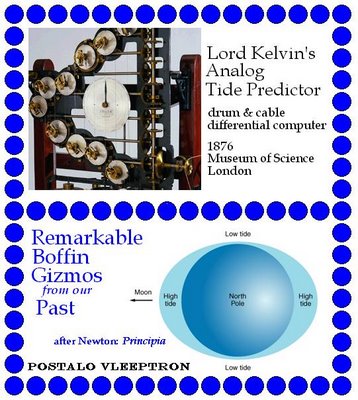09 February 2007
First Day Issue / Postalo Vleeptron / Lord Kelvin's 1876 drum and cable tide predictor
First Day Issue / Postalo Vleeptron
Lord Kelvin's 1876 drum and cable tide predictor, an analog computer to solve differential equations. Later an electrical stage of measurement and dials was added to increase precision.
In the Principia, Newton gave the first accurate scientific and mathematical explanation of the tides, which are caused by the gravitational attraction of the Moon and, to a lesser degree, the Sun.
In practice, the actual behavior of tides at a specific coastal location is affected and modified by a variety of local geological and topological factors which are difficult to describe precisely in tide equations.
Rather than performing arithmetic on discrete integers, an analog computer substitutes one physical phenomenon (angular turn of drums) for another (the cycle of local tides). Subsequent analog computers used (and still use) electric voltages as analogs of natural phenomena. These have the advantage of instantaneous computation; as soon as the question is asked electronically, the answer is generated eletronically, with no delays for software iterations. A typical analog computer can add, subtract, multiply, divide, compute trigonometric functions, differentiate and integrate. A disadvantage is that analog computers are special-purpose devices which can only perform a limited set of mathematically similar problems.
Subscribe to:
Post Comments (Atom)


1 comment:
Damn. Now I have to go back to England to see this. I've already made one trip up the hill at the Greewich Observatory to see the Harrison clocks.
Post a Comment